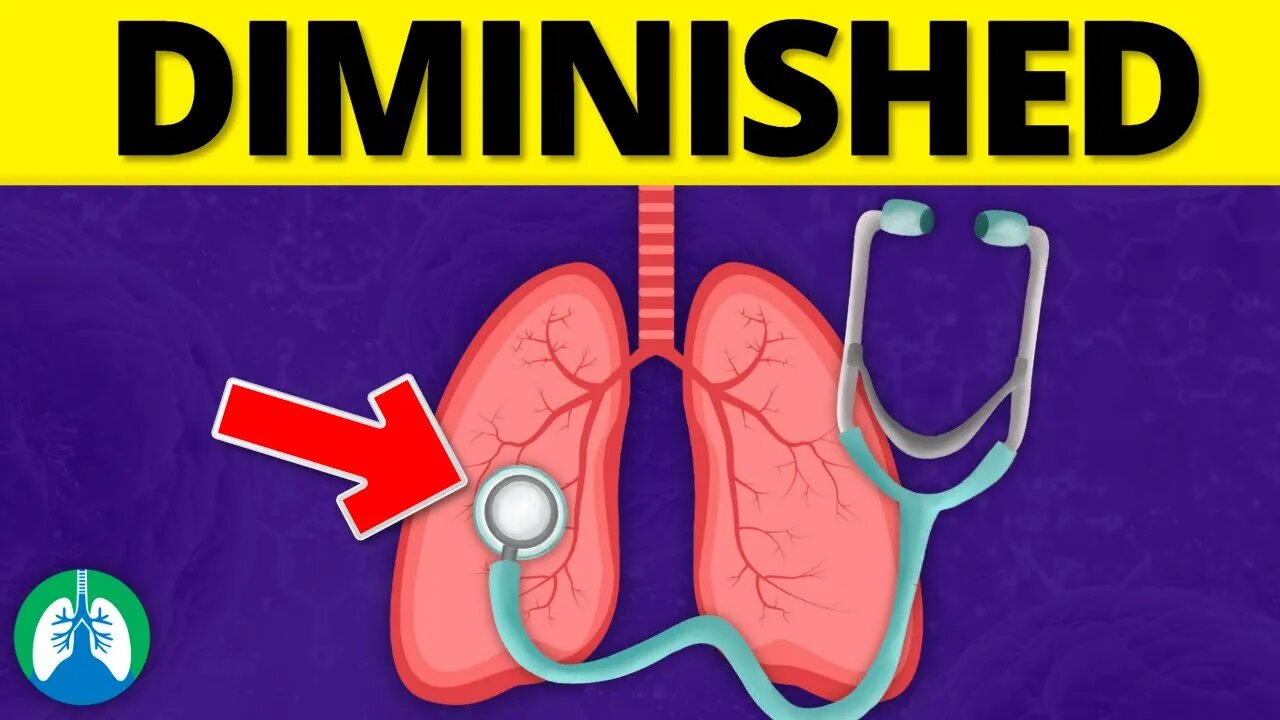Premium Only Content

Diminished Breath Sounds (Medical Definition) | Quick Explainer Video
What are diminished breath sounds? When are they heard (or not heard) during auscultation? Watch this video to find out!
💥Lung Sounds [Full Guide] ➜ ➜ ➜ http://bit.ly/2Vjd2Nr
➡️ Auscultation
Auscultation is the process of listening to the internal sounds of the lungs using a stethoscope. It is a common physical examination technique used to assess lung function and diagnose various lung conditions. During lung auscultation, the healthcare provider listens to the sounds produced by the lungs to assess the intensity, pitch, and duration. The characteristics of breath sounds can provide valuable information about the condition of the lungs, and can help healthcare providers identify potential problems such as asthma, bronchitis, pneumonia, and lung cancer.
➡️ Diminished Breath Sounds
When a patient's breath sounds are diminished, it's usually a sign of bronchoconstriction. In some cases, it's a sign of severe airflow obstruction. For example: An adult patient arrived at the emergency department in respiratory distress with diminished breath sounds, and the patient has a history of asthma. After continuous bronchodilator therapy, you heard wheezes during auscultation.
Do you know what this change suggests?
We typically think of wheezing as a bad sign during auscultation. However, in this case, it actually means that there has been some bronchodilation and improvement of air flow. When the patient arrived, their breath sounds were diminished, which means that little or no air was moving during breathing. This is a sign of severe bronchoconstriction, which often occurs during an asthma attack. But now that you can hear wheezing, it suggests that the patient's air flow has improved and their airways have opened up some thanks to the bronchodilator therapy. Understanding the causes and symptoms of diminished breath sounds, as well as the other types of lung sounds, is essential for early detection and treatment of lung conditions.
💥Lung Sounds [Full Guide] ➜ ➜ ➜ http://bit.ly/2Vjd2Nr
—————
📗 BEST STUDY GUIDES FOR YOU
▪ TMC Test Bank 👉 http://bit.ly/2IGeqSu
▪ Hacking the TMC Exam 👉 http://bit.ly/2XBc8do
▪ TMC Exam Bundle (Save $) 👉 https://bit.ly/34pqEsV
▪ Daily TMC Practice Questions 👉 http://bit.ly/2NnXh3C
💙MORE FROM RTZ
▪ Free TMC Practice Exam 👉 http://bit.ly/2XlwASL
▪ Free RRT Cheat Sheet 👉 http://bit.ly/2IbmOKB
▪ Resources for RT's 👉 http://bit.ly/2WVV5qo
▪ Testimonials 👉 http://bit.ly/2x7b5Gl
🌐FOLLOW US
▪ Instagram 👉 http://bit.ly/2FhF0jV
▪ Twitter 👉 http://bit.ly/2ZsS6T1
▪ Facebook 👉 http://bit.ly/2MSEejt
▪ Pinterest 👉 http://bit.ly/2ZwVLPw
🚑MEDICAL DISCLAIMER
This content is for educational and informational purposes only. It is not intended to be a substitute for professional medical advice, diagnosis, or treatment. Please consult with a physician with any questions that you may have regarding a medical condition. Never disregard professional medical advice or delay in seeking it because of something you watch in this video. We strive for 100% accuracy, but errors may occur, and medications, protocols, and treatment methods may change over time.
💡AFFILIATE DISCLAIMER
This description contains affiliate links. If you decide to purchase a product through one of them, we receive a small commission at no cost to you.
—————
⏰TIMESTAMPS
0:00 - Intro
0:20 - Auscultation
0:42 - Characteristics
—————
🖼CREDIT FOR MUSIC AND GRAPHICS:
▪ Music licensed from Audiojungle.net/
▪ Graphics: Canva.com, Freevector.com, Vecteezy.com, and Pngtree.com
#lungsounds #breathsounds #auscultation
-
 3:33
3:33
Respiratory Therapy Zone
1 year agoSternum (Medical Definition) | Quick Explainer Video
409 -
 2:52:15
2:52:15
Barry Cunningham
4 hours agoWATCH LIVE: PRESIDENT TRUMP SIGNS LAWS ON CRYPTO AND ENDS NPR, PBS, & USAID!
26K18 -
 44:02
44:02
The White House
3 hours agoPresident Trump Participates in a Signing Ceremony for S.1582 GENIUS Act
21.3K22 -
 LIVE
LIVE
LadyDesireeMusic
2 hours ago $0.04 earnedLive Piano Renditions | Make Ladies Great Again | Live Piano Requests TONS to choose from
114 watching -
 4:13:45
4:13:45
Viss
6 hours ago🔴LIVE - Winning with Tactics & Outplay The Competition - How To With Viss!
5.69K1 -
 1:09:46
1:09:46
Jeff Ahern
2 hours ago $0.20 earnedFriday Freak out with Jeff Ahern
12.9K7 -
 LIVE
LIVE
Spartan
2 hours agoSpartan - Pro Halo Player for OMiT | Scrims vs FaZe @ 4 EST + Ranked
12 watching -
 1:40:47
1:40:47
WolfsDenBoxing
1 hour agoStreaming Fights: New Wave or Distraction
2.35K -
 57:12
57:12
Crypto Power Hour
9 hours ago $0.23 earnedThe GENIUS Act & The Clarity Act Pass… Whats The Impact?
8.93K5 -
 2:47:39
2:47:39
Tucker Carlson
4 hours agoTucker Carlson and Darryl Cooper on the True History of Jeffrey Epstein and Ongoing Cover-Up
43.9K52